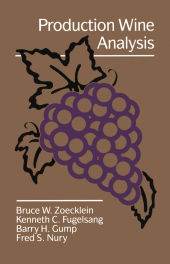 Neuerscheinungen 2012Stand: 2020-01-07 |
Schnellsuche
ISBN/Stichwort/Autor
|
Herderstraße 10
10625 Berlin
Tel.: 030 315 714 16
Fax 030 315 714 14
info@buchspektrum.de |

Bruce W. Zoecklein
Production Wine Analysis
1990. 2012. xii, 476 S. 33 SW-Abb. 229 mm
Verlag/Jahr: SPRINGER, BERLIN 2012
ISBN: 1-461-58148-6 (1461581486)
Neue ISBN: 978-1-461-58148-2 (9781461581482)
Preis und Lieferzeit: Bitte klicken
This text is designed to acquaint the reader with the commonly used procedures of juice and wine analysis as they are generally practiced in the industry, and as they are taught in the Department of Enology at California State University, Fresno. It is assumed that the reader has a basic preparation in the fields of chemistry and microbiology. In developing material for this text, the authors have emphasized analyses as they would be carried out in a production laboratory. Realizing that different laboratories have different analytical capabilities, personnel as well as equip ment, we have in many instances provided several different approaches to the same analysis. Throughout this book we have attempted to give special attention to practical considerations and the importance of these analyses in the total spectrum of winery operations. We hope the book´s format will satisfy the inter ests oflaboratory personnel as well as winemakers. The process of making wine involves a series of concerns for the winemaker and staff of a winery. The first concerns are viticultural. Upon arrival of the fruit, its quality is assessed, grapes are processed and fermentation is begun. Almost immediately, and in many instances simultaneously, chemical and microbiological stability of the young and/or aging wine become important. Finally, problems do occur on occasion, and a number of what may be consid ered remedial techniques can be employed to produce an acceptable product.
Section I-Sampling, Fermentation, and Production Analysis.- 1 / Fruit Quality and Soluble Solids.- 2 / Alcoholometry.- 3 / Extract.- 4 / Hydrogen Ion (pH) and Fixed Acids.- 5 / Volatile Acids.- 6 / Carbohydrates: Reducing Sugars.- 7 / Phenolic Compounds and Wine Color.- 8 / Oxygen, Carbon Dioxide, and Ascorbic Acid.- Section II-Microbial Stability.- 9 / Sulftir Dioxide.- 10 / Sulfur Containing Compounds.- 11 / Other Preservatives: Sorbic Acid, Benzoic Acid, and Dimethyldicarbonate.- 12 / Wine Microbiology.- Section III-Chemical Stability.- 13 / Tartaric Acid and its Salts.- 14 / Copper.- 15 / Iron and Phosphorus.- 16 / Nitrogenous Compounds.- Section IV-Remedial Actions.- 17 / Fining and Fining Agents.- 18 / Correction of Tartrate Instabilities.- 19 / Removal of Copper and Iron-The Hubach Analysis.- Appendixes.- Appendix I /Chromatographic Techniques.- Appendix II /Laboratory Reagent Preparation.- Appendix III /Laboratory Media and Stains.


